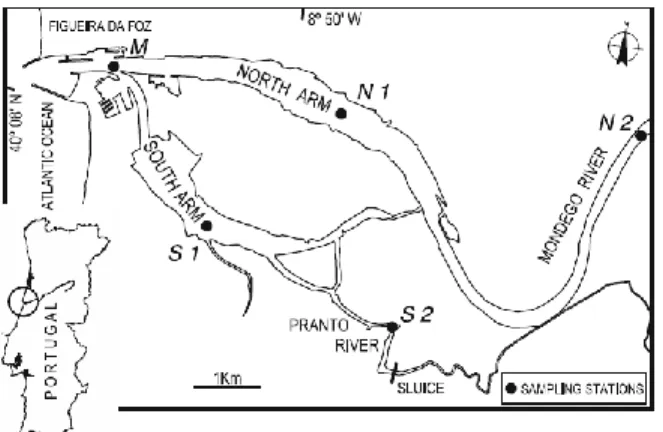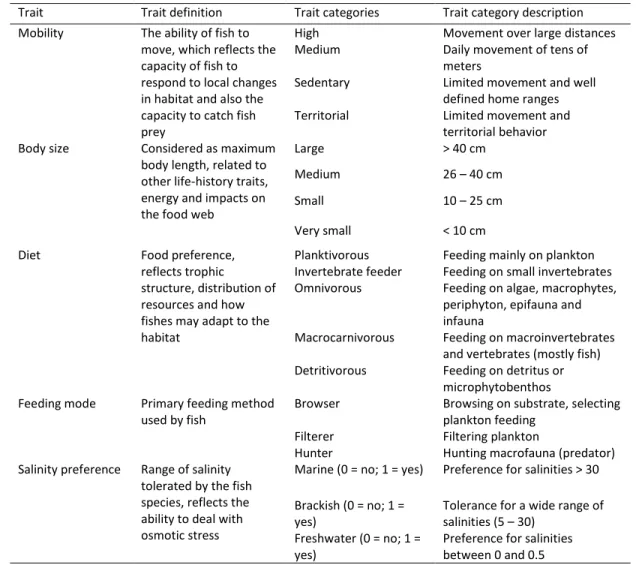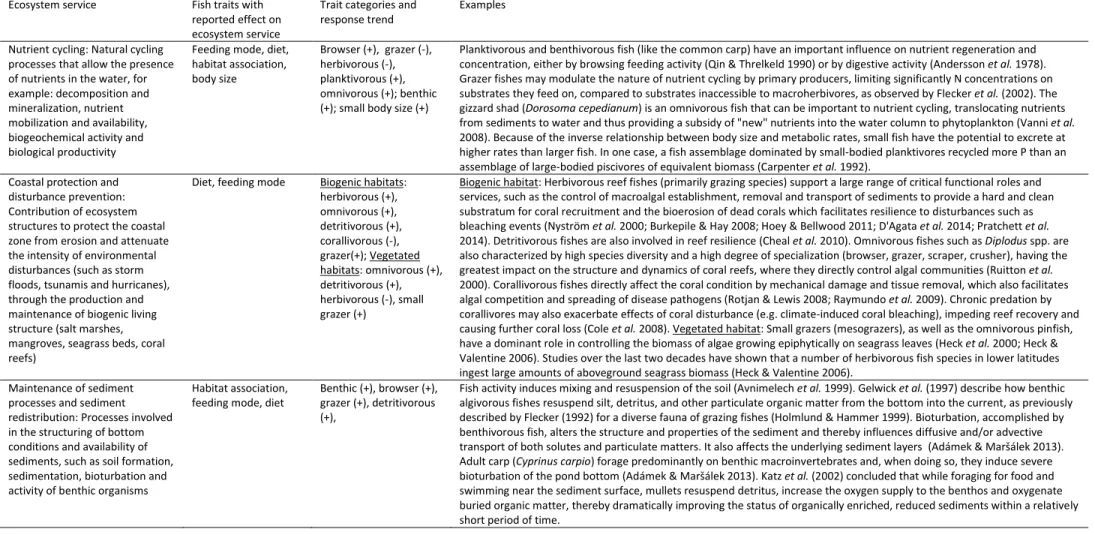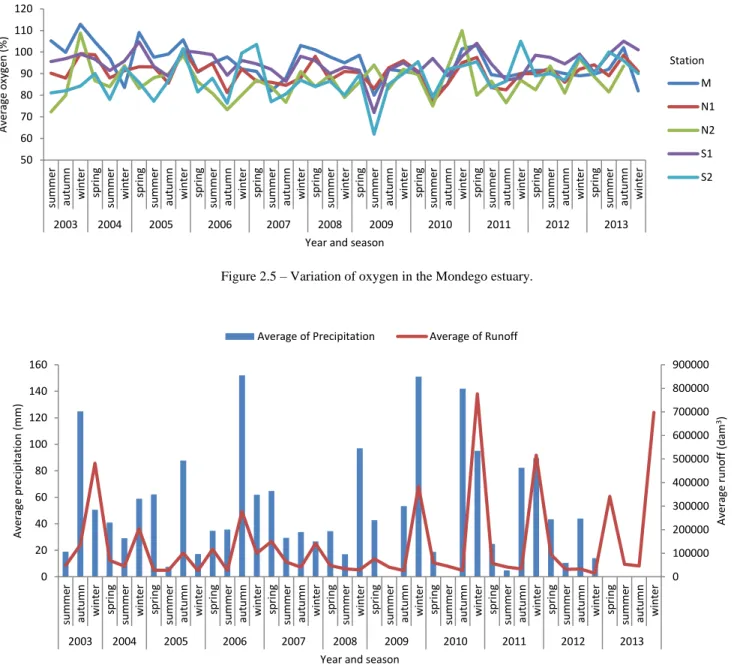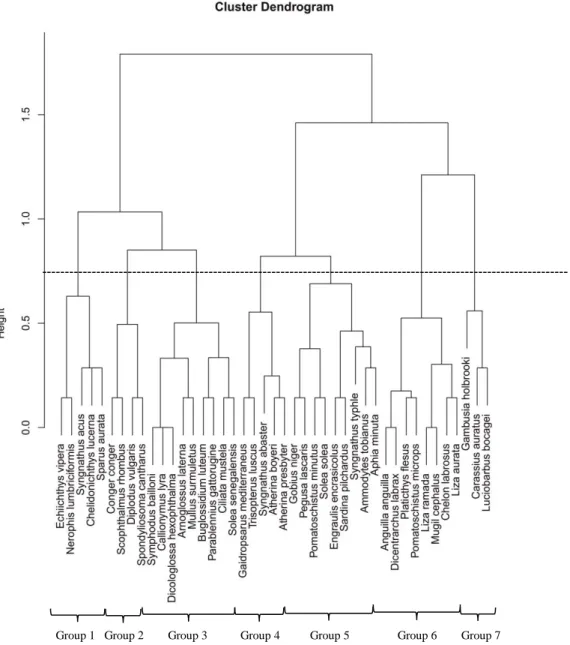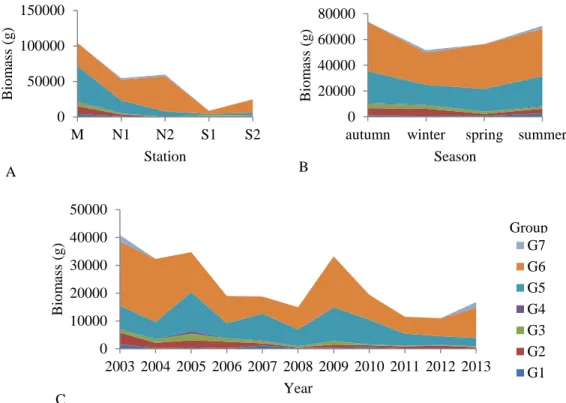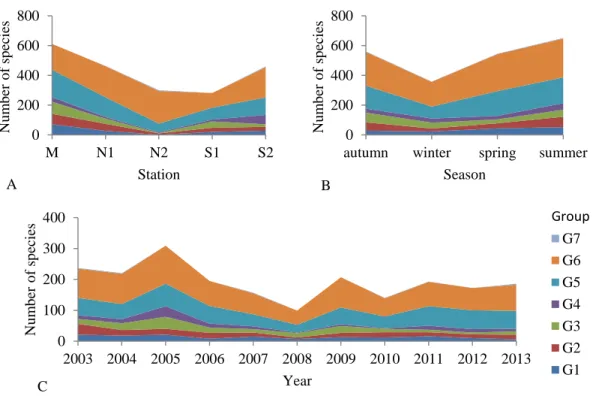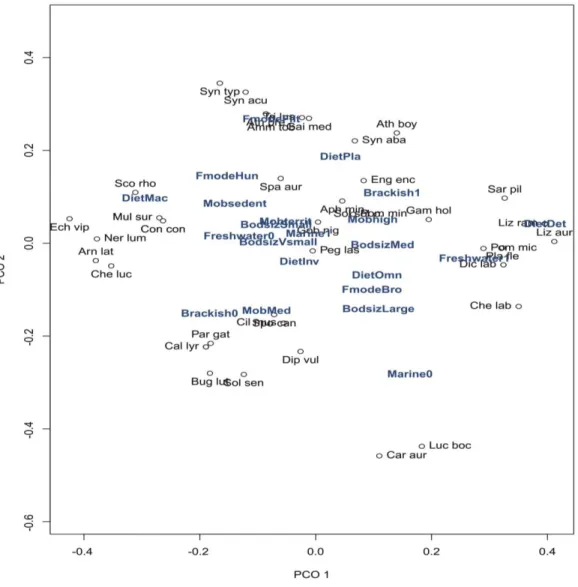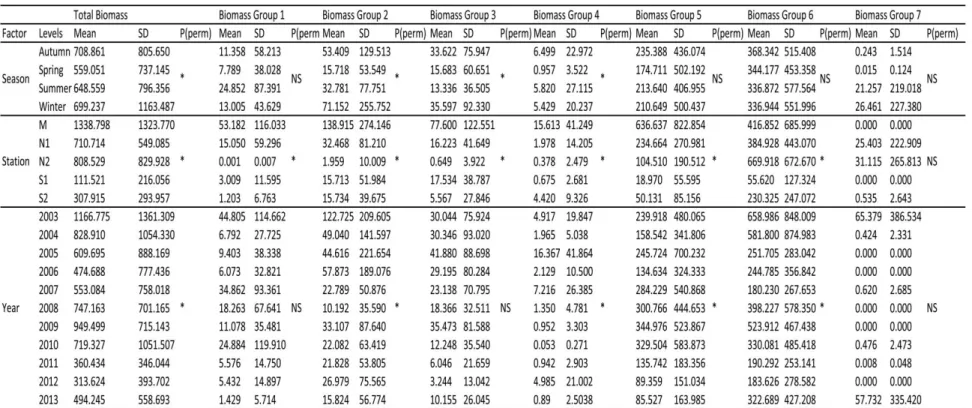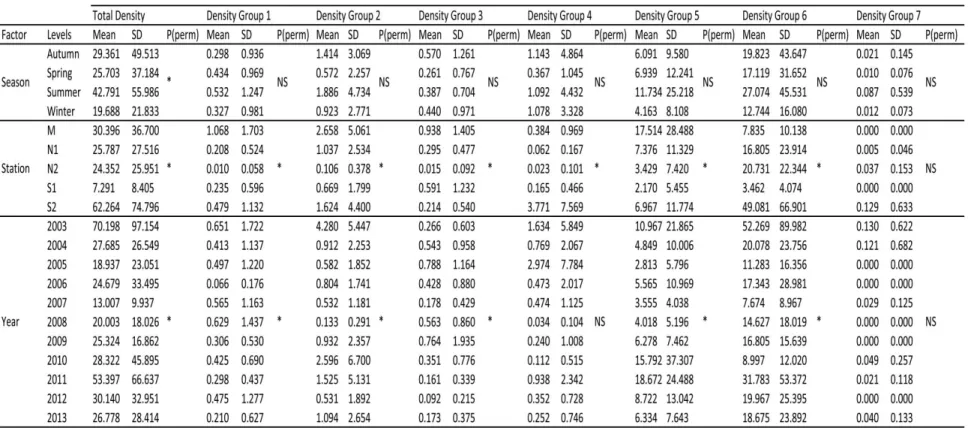UNIVERSIDADE DE LISBOA
FACULDADE DE CIÊNCIAS
DEPARTAMENTO DE BIOLOGIA ANIMAL
Assessing changes in ecosystem functioning and services via
functional traits of an estuarine fish assemblage
Mestrado em Ecologia Marinha
Margarida Avillez Ataíde Oliveira Monteiro
Dissertação orientada por:
Doutora Rita Vasconcelos
Doutora Sofia Henriques
ii
“Look deep into nature, and then you will understand everything better.” Albert Einstein
ACKNOWLEDGEMENTS
Acknowledgements
I couldn’t have finished this master thesis without thanking all the people that made it possible and were present through my path, particularly:
Doutora Rita Vasconcelos for accepting me as a master student, for all the support during this study, all the patience and suggestions, and availability to clarify my questions;
Doutora Sofia Henriques for accepting me as a master student, for all the support during this study, all the advices and sincerity, and availability to clarify my questions;
Doutor Filipe Martinho for showing me the Mondego estuary, providing important data to my analysis, and all the help through this study;
Doutora Marina Dolbeth for all the support, suggestions and for clarifying my doubts;
Fábio Monteiro for sharing this road through master thesis, for being my colleague, all the support and amusement, and all the help;
Irina Duarte, for all the advices and companionship;
All the teachers who inspired me and opened my eyes during my times in college; My friends, for all the support and for keeping my head up;
My family, especially my parents and my grandmother, who gave me support during all this work; And last but not the least, my dog Shot, who was there for me every time, being the best friend in the world.
Research was funded with project PTDC/MAR/117119/2010, MARE with project UID/MAR/04292/2013, S. Henriques and Marina Dolbeth with Post-Doc grant (respectively SFRH/BPD/94320/2013 and SFRH/BPD/110441/2015), R.P. Vasconcelos and Filipe Martinho with Investigador FCT Programme through funds from the European Social Fund and the Portuguese Operational Human Potential Program (respectively IF/00058/2013 and IF/01410/2012), all from Fundação para a Ciência e a Tecnologia.
ABSTRACT AND KEYWORDS
Abstract
Biodiversity loss is a pressing global issue. Yet, there is limited knowledge on the consequences of species loss for ecosystem functioning and services. The main objective of this study was to assess the potential influence on the provision of ecosystem services exerted by an estuarine fish assemblage via functional traits, and possible temporal and spatial variations.
To explore links between fish biodiversity and ecosystem functioning and services we reviewed the literature for evidence on relationships between fish functional traits (e.g. body size, diet) and ecosystem service provision to humankind (e.g. nutrient cycling and biological control). Additionally, we used a time-series data on an estuarine fish assemblage (Mondego estuary, Portugal, sampled between 2003 and 2013) as a practical case-study for further developing our approach. For each fish species we assembled data on five functional traits and identified functional groups of species (e.g. through hierarchical cluster analysis). We characterized the potential contribution of the Mondego fish assemblage to the functioning of the ecosystem and its service provision. In addition, we determined the degree of functional redundancy in the fish assemblage, towards an evaluation of the degree of resilience of this assemblage in contributing to ecosystem functioning and service provision.
The most important functional traits identified in the literature review to regulating services were feeding mode, diet and body size and their effects depended on both service and ecosystem. We identified seven functional groups in the fish assemblage, with potential to contribute to all regulating services analysed, except air purification, namely: nutrient cycling, coastal protection and disturbance prevention, maintenance of sediment processes and sediment redistribution, biological control, climate regulation, waste treatment and assimilation and regulation of linkages between ecosystems. However, this contribution was not equal for all groups, as each one was linked to specific services and differently represented in the fish assemblage. Also, fish functional groups showed spatial and inter-annual variation, which is probably associated with environmental conditions. The majority of fish functional traits measures were significantly correlated with salinity, temperature and oxygen and showed strong spatial and annual variation, despite a weak seasonal variation. Functional redundancy of the fish assemblage showed spatial and seasonal variations, which may be related with differences in abundance of species between stations, probably due to different environmental conditions, and seasons, which influence recruitment periods of some species. The annual functional redundancy differed between groups, with group 7 showing null values, possibly being the most vulnerable group to disturbance, and groups 5 and 6 showing the highest values, which may mean they contribute in a more resilient manner to the the provision of ecosystem services such as waste treatment and assimilation and climate regulation.
This study is the first one to assess the provision of ecosystem services by the fish assemblage of the Mondego estuary through their functional traits and estimate their resilience. Future studies should develop the quantification of ecosystem services provided by fish in ecological and economical perspectives, assess the impacts of anthropogenic pressures in functional composition of fish assemblages and thus in the ecosystem services they can provide, and also estimate the resilience of those fish assemblages, which is essential to prioritize conservation efforts of fish assemblages and safeguard the services they provide.
ABSTRACT AND KEYWORDS
vi
RESUMO E PALAVRAS-CHAVE
Resumo
A perda de biodiversidade é um problema urgente à escala global. Contudo, o conhecimento sobre as consequências da perda de espécies para o funcionamento e serviços dos ecossistemas é limitado. O principal objectivo deste estudo foi avaliar a potencial influência na provisão de serviços de ecossistema exercida por uma associação de peixes estuarinos através das características funcionais, e as suas possíveis variações temporais e espaciais.
Para explorar as ligações entre a biodiversidade de peixes e o funcionamento e serviços de ecossistema, fizemos uma revisão da literatura para encontrar evidências de relações entre características funcionais de peixes (e.g. tamanho do corpo, dieta) e o funcionamento de ecossistemas/provisão de serviços à humanidade (e. g. reciclagem de nutrientes e controlo biológico). Adicionalmente, usámos uma série cronológica da composição taxonómica de uma associação de peixes estuarina (estuário do Mondego, Portugal, amostrada entre 2003 e 2013) como caso prático de estudo para desenvolver a nossa abordagem. Para cada espécie de peixe, reunimos dados acerca de cinco características funcionais e identificámos grupos funcionais de espécies (e.g. através de análise hierárquica de agrupamento). Caracterizámos a contribuição da associação de peixes do Mondego para o funcionamento do ecossistema e a sua provisão de serviços. Além disso, determinámos o nível de redundância funcional da associação de peixes, para uma avaliação do grau de resiliência desta associação ao contribuir para o funcionamento do ecossistema e provisão de serviços.
As características funcionais mais importantes identificadas na revisão de literatura para os serviços de regulação foram o modo de alimentação, a dieta e o tamanho do corpo e os seus efeitos dependem do serviço e do ecossistema. Identificámos sete grupos funcionais na associação de peixes, com potencial para contribuir para todos os serviços reguladores de ecossistema, excepto purificação do ar, nomeadamente: reciclagem de nutrientes, protecção da costa e prevenção de perturbações, manutenção de processos sedimentares e de redistribuição sedimentar, controlo biológico, regulação do clima, tratamento e assimilação de desperdícios e regulação de ligações entre ecossistemas. No entanto, esta contribuição não foi igual para todos os grupos, já que cada um está ligado a serviços específicos e diferentemente representado na associação de peixes. Além disso, os grupos funcionais de peixes mostraram variação espacial e inter-anual, o que está provavelmente associado a condições ambientais. A maioria das medidas de características funcionais das espécies foram significativamente correlacionadas com a salinidade, temperatura e oxigénio e mostraram uma forte variação espacial e anual, apesar de uma fraca variação sazonal. A redundância funcional da associação de peixes mostrou variação espacial e sazonal, o que pode estar relacionado com diferenças na abundância de espécies entre estações de amostragem, provavelmente devido a diferentes condições ambientais e estações do ano, que influenciam os períodos de recrutamento de algumas espécies. A redundância funcional média anual variou entre grupos, com o grupo 7 a mostrar valores nulos, sendo possivelmente o grupo mais vulnerável a perturbações e os grupos 5 e 6 a mostrar os valores mais altos, o que pode significar que eles contribuem de uma maneira mais resiliente para a provisão de serviços de ecossistema como o tratamento e assimilação de desperdícios e a regulação do clima.
Este estudo foi o primeiro a avaliar a provisão de serviços de ecossistema relacionados com a associação de peixes do estuário do Mondego através das suas características funcionais e a estimar a sua resiliência. Estudos futuros deverão desenvolver a quantificação de serviços de ecossistema fornecidos por
RESUMO E PALAVRAS-CHAVE
viii
peixes do ponto de vista ecológico e económico, avaliar os impactos das pressões antropogénicas na composição funcional de associações de peixes e nos serviços de ecossistema que elas conseguem fornecer, e também estimar a resiliência dessas associações de peixes, a qual é essencial para prioritizar esforços de conservação em associações de peixes e salvaguardar os serviços que elas fornecem.
Palavras-chave: associação de peixes; estuários; serviços de ecossistema; características funcionais;
RESUMO ALARGADO E PALAVRAS-CHAVE
Resumo alargado
A biodiversidade de organismos a todos os níveis (taxonómico, funcional e genético) é essencial para o ser humano, fornecendo recursos naturais e afectando processos ecológicos importantes (e.g. produção de biomassa e fotossíntese), que controlam os fluxos de nutrientes, energia e matéria orgânica pelo ambiente, além de mediarem o fornecimento de serviços de ecossistema. Os serviços de ecossistema são as contribuições directas e indirectas dos ecossistemas para o bem-estar humano e podem ser de vários tipos, conforme a classificação usada – de acordo com a Economia dos Ecossistemas e Biodiversidade são: provisão, regulação, cultural e de habitat. A biodiversidade tem um papel fundamental no fornecimento de serviços de ecossistema, e especialmente as características funcionais dos organismos, isto é, as que influenciam directamente o seu desempenho e são mensuráveis ao nível individual (e.g. tamanho do corpo e mobilidade) são muito úteis para descrever a contribuição das espécies para o funcionamento dos ecossistemas e para a entrega de serviços de ecossistema.
A sobre-exploração de recursos naturais pelo ser humano, bem como outras actividades antropogénicas, tem levado à degradação dos ecossistemas e a alterações na estrutura e composição das comunidades biológicas, o que afecta o funcionamento dos ecossistemas e diminui a sua capacidade de fornecimento de serviços. Assim, torna-se necessário compreender até que ponto é que os ecossistemas podem absorver perturbações e conseguir manter as suas características essenciais, capacidade esta a que se dá o nome de resiliência.
Os estuários são sistemas de transição entre água doce e salgada, que constituem importantes habitats para espécies de peixes, oferecendo refúgio de predadores, áreas de viveiro e pontos de passagem para migrações, além de zonas de reprodução e alimentação. Em geral, os sistemas estuarinos apresentam flutuações nas suas condições ambientais, o que leva a que as comunidades que neles habitam apresentem uma certa capacidade de adaptação. Contudo, por apresentarem elevada produtividade, são também intensamente explorados pelas populações humanas, o que tem vindo a comprometer a sua integridade e a alterar as suas comunidades biológicas.
Este estudo pretendeu avaliar a influência na provisão de serviços de ecossistema exercida por uma associação de peixes de um estuário através das suas características funcionais, bem como a sua variação espacial e temporal. Como caso de estudo, considerou-se a associação de peixes do estuário do Mondego, a qual tem sido monitorizada há mais de uma década. Especificamente, os objectivos foram: obter informação sobre ligações entre características funcionais de peixes e a provisão de serviços de ecossistema (com base numa revisão de literatura); identificar grupos funcionais de peixes dentro do estuário do Mondego (grupos de espécies com características funcionais semelhantes) e a sua possível contribuição para a provisão de serviços reguladores de ecossistema; investigar padrões de variação das características funcionais dos peixes e dos grupos funcionais e sua relação com os factores ambientais subjacentes; explorar a resiliência dos serviços de ecossistema fornecidos pela associação de peixes através do cálculo da redundância funcional (número de espécies que desempenham funções semelhantes).
A revisão de literatura permitiu identificar ligações entre características funcionais de peixes e a provisão de serviços reguladores de ecossistema, embora a maioria das ligações fosse indirecta. As características funcionais com maior número de ligações a este tipo de serviços foram o modo de alimentação, a dieta e o tamanho do corpo. Os serviços reguladores de ecossistema com maior número de ligações a características funcionais foram a reciclagem de nutrientes, a protecção costeira e prevenção de perturbações, o controlo biológico e a regulação de ligações entre ecossistemas. Após a caracterização
RESUMO ALARGADO E PALAVRAS-CHAVE
x
funcional da associação de peixes em estudo, tendo em conta cinco características funcionais (mobilidade, tamanho do corpo, dieta, modo de aquisição do alimento e preferência de salinidade), bem como uma análise hierárquica de agrupamento, foram identificados sete grupos funcionais de peixes no estuário do Mondego, com capacidade para fornecer diferentes serviços reguladores de ecossistema: reciclagem de nutrientes, controlo biológico, manutenção de processos sedimentares e de redistribuição de sedimentos, protecção costeira e prevenção de perturbações, regulação do clima, tratamento e assimilação de desperdícios e regulação de ligações entre ecossistemas. No estuário do Mondego, a comunidade de peixes parece influenciar de forma mais importante os seguintes serviços de ecossistema: a reciclagem de nutrientes, o controlo biológico, a regulação do clima e o tratamento e assimilação de desperdícios. Para todas as análises relativas à associação de peixes e grupos funcionais, foram consideradas três medidas: biomassa, densidade e número de espécies. As variações dos grupos funcionais observadas na análise foram sobretudo temporais e espaciais, o que estará provavelmente relacionado com alterações nos padrões climatéricos ao longo do período de amostragem (no primeiro caso) e com diferentes condições ambientais nos locais de amostragem, sobretudo em relação à salinidade, temperatura e oxigénio (no segundo caso). No entanto, também foram observadas variações sazonais para alguns grupos funcionais, ainda que menores, que podem estar relacionadas com a temperatura e períodos de recrutamento, já que estes grupos contêm espécies marinhas migradoras e que utilizam o estuário como zona de viveiro.
A relação entre as características funcionais e as variáveis ambientais (salinidade, temperatura, percentagem de oxigénio dissolvido, precipitação, escoamento e índice NAO) foi explorada através de modelos lineares generalizados e modelos de partição hierárquica de variância. Estas análises evidenciaram uma pequena influência significativa da salinidade, temperatura e oxigénio e especialmente uma elevada percentagem de variação explicada sobretudo pelo local e ano. Para a maioria das características funcionais, o ano de 2003 foi o ano com valores mais elevados e o ano de 2006 foi o ano em que se registaram valores mais baixos - o que poderá estar relacionado com a baixa salinidade (devida a forte precipitação) e com o facto de a maioria das espécies do estuário do Mondego serem marinhas.
Finalmente, foi avaliada a redundância funcional desta associação de peixes com o objectivo de avaliar a resiliência da influência desta comunidade no fornecimento de serviços reguladores de ecossistema. A redundância funcional da associação de peixes em estudo variou sazonal e espacialmente, com valores mais elevados na primavera e no local de amostragem mais a montante. Em relação aos sete grupos funcionais desta associação, a redundância funcional (média anual) foi mais elevada para os grupos 5 e 6 (os que apresentam maior densidade, biomassa e riqueza) e mais baixa para os grupos 1 e 4, com o grupo 7 a mostrar valores nulos, o que poderá significar que é o grupo menos resiliente e cuja provisão de serviços será mais afectada com a perturbação e perda de espécies. Assim, os serviços de ecossistema mais resilientes nesta associação de peixes serão os fornecidos pelos grupos 5 e 6, nomeadamente: tratamento e assimilação de desperdícios, regulação do clima, reciclagem de nutrientes e controlo biológico. No entanto, o grupo 6 também tem capacidade para fornecer outros serviços de ecossistema, como a protecção costeira e prevenção de perturbações, manutenção de processos sedimentares e redistribuição de sedimentos e regulação de ligações entre ecossistemas, o que pode aumentar a resiliência destes serviços. No entanto, isto depende do funcionamento do ecossistema, o qual é condicionado por múltiplas variáveis, incluindo a resposta das espécies à perturbação e as interacções entre espécies, aspectos estes que deverão ser investigados em estudos futuros.
Este estudo constitui uma abordagem ao estudo da relação entre as características funcionais de uma comunidade de peixes estuarinos e o fornecimento dos serviços de ecossistema que poderá ser facilmente aplicada a outros estuários e constitui um passo importante para a compreensão da influência da
RESUMO ALARGADO E PALAVRAS-CHAVE
biodiversidade sobre o bem-estar humano. Além disso, ao avaliar a redundância funcional para esta associação de peixes, este estudo permitiu estimar o seu grau de resiliência, o que é importante para a sua conservação e para a manutenção do funcionamento deste ecossistema. A estimativa do grau de resiliência distinguiu os serviços de ecossistema mais importantes no estuário e a capacidade de manutenção de serviços pelos grupos funcionais da associação de peixes estudada. Os grupos funcionais com maiores valores de biomassa, densidade e número de espécies mostraram ser os mais resilientes na provisão de serviços de ecossistema, o que mostra a influência da quantidade de espécies para a redundância funcional e consequentemente para a resiliência de serviços de ecossistema.
No futuro, deverão ser realizados mais estudos sobre ligações entre peixes e serviços de ecossistema (especialmente porque este grupo biológico é muito afectado pela pesca e por alterações ambientais) nomeadamente para o desenvolvimento de outras formas de quantificação directa de serviços de ecossistema fornecidos por peixes. É ainda importante investigar directamente os efeitos de pressões antropogénicas na composição funcional das comunidades de peixes e consequentemente no funcionamento dos ecossistemas.
Palavras-chave: associação de peixes; estuários; serviços de ecossistema; características funcionais;
TABLE OF CONTENTS
TABLE OF CONTENTS
ACKNOWLEDGEMENTS iii
ABSTRACT AND KEYWORDS v
RESUMO E PALAVRAS-CHAVE vii
RESUMO ALARGADO E PALAVRAS-CHAVE ix
CHAPTER 1 1
General introduction CHAPTER 2 11
Assessing temporal variation on ecosystem functioning and services via functional traits of an estuarine fish assemblage CHAPTER 3 61
Final Remarks APPENDIX I 71
APPENDIX II 75
LIST OF FIGURES
LIST OF FIGURES
Figure 2.1 - The Mondego estuary, with the location of the five sampling sites. 17 Figure 2.2 - Illustration of fish traits and ecosystem services general relationships. Green arrows indicate positive relationships and red arrows indicate negative relationships between each trait and ecosystem
service. 21
Figure 2.3 – Variation of salinity in the Mondego estuary. 26
Figure 2.4 – Variation of temperature in the Mondego estuary. 26 Figure 2.5 - Variation of oxygen in the Mondego estuary. 27 Figure 2.6 – Variation of precipitation and runoff in the Mondego estuary. 27 Figure 2.7 - Dendrogram produced by cluster analysis of the fish assemblage of the Mondego estuary based on five traits (mobility, body size, diet, feeding mode and salinity preference). 28 Figure 2.8 - Variation of fish functional groups (quantified by the sum of cumulative biomass of a group in all samples) in the Mondego estuary. A – Spatial variation. B – Seasonal variation. C – Temporal variation. 30 Figure 2.9 – Variation of fish functional groups (quantified by the sum of cumulative density of a group in all samples) in the Mondego estuary. A – Spatial variation. B – Seasonal variation. C – Temporal variation. 30 Figure 2.10 – Variation of fish functional groups (quantified by the sum of the cumulative number of species of a group in all samples) in the Mondego estuary. A – Spatial variation. B – Seasonal variation. C – Temporal variation. 31 Figure 2.11 – Principal Coordinates Analysis comparing the fish assemblage of the Mondego estuary based on five traits: mobility, body size, diet, feeding mode and salinity preference (Mobility categories: Mobhigh – high; MobMed – medium; Mobterrit – territorial; Mobsedent – sedentary. Body size categories: BodsizLarge – large; BodsizMed – medium; BodsizSmall – small; BodsizVsmall – very small. Diet categories: DietPla – planktivorous; DietInv – invertebrate feeders; DietOmn – omnivorous; DietMac – macrocarnivorous; DietDet – detritivorous. Feeding mode categories: FmodeBro – browsers; FmodeFil – filterers; FmodeHun – hunters). Salinity preference categories are represented by Marine, Brackish and Freshwater (0 – no; 1 – yes). Species names are abbreviated. See full species names in Figure 2.7 (the abbreviation includes the first three letters of both genus and species). 32
LIST OF TABLES
xvi
LIST OF TABLES
Table 2.1 - List of the fish functional traits compiled for all species. 19 Table 2.2 - Summary of fish traits and ecosystem services relationships. Response trend is given within parentheses (+ for positive or – for negative). The classification of ecosystem services was adapted from Holmlund and Hammer (1999), de Groot et al. (2010) and Hattam et al. (2015). 23 Table 2.3 - PERMANOVA results for the differences in biomass of each functional group concerning factors season, station and year. For each test the mean, standard deviation (SD) and p-value - P(perm) - are represented (* for p-p-value < 0.05, NS for non-significant p-p-value). 34 Table 2.4 - PERMANOVA results for the differences in density of each functional group concerning factors season, station and year. For each test the mean, standard deviation (SD) and p-value - P(perm) - are represented (* for p-p-value < 0.05, NS for non-significant p-p-value). 35 Table 2.5 - PERMANOVA results for the differences in species number of each functional group concerning factors season, station and year. For each test the mean, standard deviation (SD) and p-value - P(perm) - are represented (* for p-p-value < 0.05, NS for non-significant p-p-value). 36 Table 2.6 - Generalized Linear Model (GLM) fitted to the response of traits (in biomass) to environmental variables. The table presents for each variable: Sig - the significance of the variable in a full Generalized Linear Model (* p-value < 0.05), % - percentage of variance explained by the variable and C - coefficient signal (+ or -) estimated in Hierarchical Partition of Variance. Two alternative models were fitted for each trait: with and without factors (season, station, year),
represented by A and B, respectively. 38
Table 2.7 - Generalized Linear Model (GLM) fitted to the response of traits (in density) to environmental variables. The table presents for each variable: Sig - the significance of the variable in a full Generalized Linear Model (* p-value < 0.05), % - percentage of variance explained by the variable and C - coefficient signal (+ or -) estimated in Hierarchical Partition of Variance. Two alternative models were fitted for each trait: with and without factors (season, station, year),
represented by A and B, respectively. 39
Table 2.8 - Generalized Linear Model (GLM) fitted to the response of traits (in number of species) to environmental variables. The table presents for each variable: Sig - the significance of the variable in a full Generalized Linear Model (* p-value < 0.05), % - percentage of variance explained by the variable and C - coefficient signal (+ or -) estimated in Hierarchical Partition of Variance. Two alternative models were fitted for each trait: with and without factors (season, station, year), represented by A and B, respectively. 40 Table 2.9 - Functional redundancy (FR) by season, station and year for total biomass of species and for each functional group, represented by mean, standard-deviation (SD) and p-value from PERMANOVA (* for p-value < 0.05, NS for non-significant p-value. 42
LIST OF TABLES
Table 2.10 - Functional redundancy (FR) by season, station and year for total density of species and for each functional group, represented by mean, standard-deviation (SD) and p-value from PERMANOVA (* for p-value < 0.05, NS for non-significant p-value). 43
CHAPTER 1
CHAPTER 1
General introduction
Biodiversity is currently understood as the “variability among living organisms and their habitats from all sources, including diversity within species, between species and within entire ecosystems” (Pinto et al. 2014) and considering all components – taxonomic, functional and phylogenetic diversity (Purschke et al. 2013). It is crucial to human welfare, both directly and indirectly, as it provides natural resources (e.g. food and drinkable water) and also affects important ecosystem functions (i. e. ecological processes that control the fluxes of energy, nutrients and organic matter through the environment; Cardinale et al. 2012), such as biomass production and soil formation, which mediate the provision of ecosystem services (Daily 1997; Díaz et al. 2006).
Ecosystem services (ES) constitute “the direct and indirect contributions of ecosystems to human well-being” (de Groot et al. 2010) and are essential to human survival (Kremen 2005). It is therefore necessary to classify them in a comprehensive way (Atkins et al. 2011). According to the Millennium Ecosystem Assessment (2005), there are four types of ecosystem services: provisioning (e.g. food and drinkable water), regulating (e.g. climate regulation and water purification), cultural (e.g. aesthetic and recreational values) and supporting (e.g. nutrient cycling and primary production). However, this classification has been challenged, for example, for considering supporting services as directly beneficial to humans, when they actually constitute a basic support to the provision of other services (Böhnke-Henrichs et al. 2013). Since then, other classifications have been developed (Beaumont et al. 2007; Fisher et al. 2009; de Groot
et al. 2010; Atkins et al. 2011; Böhnke-Henrichs et al. 2013; Liquete et al. 2013; Hattam et al. 2015),
which have gained more consensus, including the one from de Groot et al. (2010), which classifies ecosystem services in four categories: provisioning, regulating, cultural and habitat. This last category includes the services of life cycle maintenance of migratory species and gene pool protection, which are dependent of the state of the habitat (de Groot et al. 2010). There has been an evolution of knowledge about ecosystem services in recent decades (Farber et al. 2006; Worm et al. 2006; Boyd & Banzhaf 2007; Wallace 2007; Liquete et al. 2013), which is important for conservation and management purposes (Costanza et al. 1997).
Several approaches have been developed to clarify the relationship between biodiversity and ecosystem services, exploring the contribution of habitats (Chan et al. 2006) and the roles of individual species and groups of species in ecosystem functioning (Hooper et al. 2005; Díaz et al. 2007; Luck et al. 2009; Harrison et al. 2014). Moreover, according to Luck et al. (2009), it is necessary to identify the organisms and their characteristics that are linked with the provision of services and also determine how changes in these organisms affect those services. In this sense, functional traits (i.e. characteristics of organisms directly influencing the organism's performance, for example body size and mobility; Mouillot et al. 2012) are useful predictors to describe links between species, ecosystem functioning and ecosystem service delivery (Lavorel & Garnier 2002; Díaz et al. 2004; Hooper et al. 2005; de Bello et al. 2010; Harrison et al. 2014; Gagic et al. 2015). These linkages have been predominantly studied for some groups of organisms such as plants, for which there is abundant evidence of associations between traits and services (de Bello et al. 2010).
There has been a considerable increase in the number of studies investigating the complex role of biodiversity (chiefly species richness) on ecosystem functioning (Worm et al. 2006; Lefcheck et al. 2015), as well as regarding the influence of species traits in the functional structure of ecosystems (de Bello et al.
CHAPTER 1
4
2010; Cardinale et al. 2012; Gagic et al. 2015) and on ecosystem functioning and the provision of ecosystem services (Balvanera et al. 2006; Harrison et al. 2014). Some studies developed the concept of functional groups – groups of species with similar functional traits – which is useful in the context of evaluating the provision of ecosystem services since groups can be defined based on functional traits that are important to services of interest (Lavorel et al. 1997; McGrady-Steed et al. 1997; Gerino et al. 2003; Luck et al. 2009; García-Llorente et al. 2011). For example, García-Llorente et al. (2011) showed the potential contribution of each functional group of aquatic plants to the delivery of ecosystem services such as provisioning of medicine resources, aesthetic values, consumption by livestock, and water filtration. Also, Gerino et al. (2003) assigned macro-invertebrates into functional groups considering different types of aquatic sediments, which contributed to a better understanding of ecological processes such as bioturbation (i.e. “reworking and mixing of sediment at the sediment-water interface, accomplished by activities of benthic organisms, which alter the structure and properties of sediment and influence the transport of solutes and particulate matter"; Adámek & Maršálek 2013) which mediates the maintenance of sediment processes, according to Holmlund and Hammer (1999).
The increasing degradation of ecosystems due to anthropogenic activities and over-exploitation of natural resources lead to alterations in the structure and composition of biological communities (Kremen 2005; Díaz et al. 2006). Moreover, these human-induced alterations can originate loss of key species that perform particular functions on which important ecosystem processes such as bioturbation and primary productivity (Solan et al. 2004) depend, which can decrease the capacity of ecosystems to provide essential services (Mouillot et al. 2013; Pratchett et al. 2014). Thus, it is necessary to estimate the capacity of ecosystems to absorb disturbance and retain their essential characteristics - meaning estimating their ecological resilience (Holling 1973). Elmqvist et al. (2003) emphasizes the role of biodiversity for ecosystem resilience in the face of undergoing change, as also referred by Walker (1992) and Norberg et
al. (2001). Moreover, it is currently widely accepted that, in addition to taxonomic-based diversity indices,
functional and phylogenetic diversity should be studied in order to assess ecosystem resilience (Meynard
et al. 2011; Gagic et al. 2015). In this context, different approaches have been developed, for example,
suggesting that resilience of ecosystems depends on the variety and distribution of functional groups (Peterson et al. 1998; Gunderson 2000) and on diversity of species within these groups (Luck et al. 2003). Furthermore, Mouillot et al. (2014) highlighted the role of functional redundancy (i.e. the number of different species that perform similar ecological functions; Micheli & Halpern 2005) in preserving ecosystem functioning after decrease of species diversity. Also, the response of species with similar functions to environmental variation – called “response diversity” - is also crucial to ecosystem resilience (Elmqvist et al. 2003; Folke et al. 2004), because if all these species are equally vulnerable to disturbance, functional redundancy is not sufficient to maintain ecosystem functioning (Hughes et al. 2005; Muntadas
et al. 2016). For instance, rare species may have an important role in this process, since they can share
similar functional traits with common species but may respond differently to stress (Boero 1994; Walker
et al. 1999; Lyons et al. 2005; Mouillot et al. 2013). Although it is still difficult to measure resilience,
certain indicators can be used to estimate it, such as functional diversity (Peterson et al. 1998; Elmqvist et
al. 2003), functional redundancy (de Bello et al. 2007; van der Linden et al. 2012; Mouillot et al. 2014;
Muntadas et al. 2016) and functional vulnerability (i.e. potential decrease of functional diversity after species loss; Mouillot et al. 2014). Moreover, it is important to consider the capacity of adaptation by species, which can change their functional roles in different environmental contexts (Wellnitz & Poff 2001).
CHAPTER 1
Estuaries are transitional systems that are extremely productive and valuable for human society, being highly explored (Costanza et al. 1997; Kennish 2002; Barbier et al. 2011). Also, they are significantly important for fish communities, since they provide reproduction habitats, nursery grounds, migratory routes and protection from predators (Beck et al. 2001; Martinho et al. 2008; Baptista et al. 2013; Fonseca
et al. 2013) being essential to the maintenance and regeneration of numerous fishery resources (Nicolas et al. 2007; Vasconcelos et al. 2011). However, these systems are subject to high anthropogenic pressure and
environmental alterations, which are increasingly deteriorating their integrity and also affecting important ecological processes, such as biogeochemical cycling and flux regulation of water and pollutants (Kennish 2002; Borja et al. 2010; Barbier et al. 2011). The loss of large predators and herbivorous species, habitats for reproduction and filtering capacity are some of the changes in structure and functioning that result from over-exploitation and degradation of estuarine systems (Lotze et al. 2006), and that affect the delivery of critical ecosystem services, such as sustainable fisheries, provision of nursery habitats, cleansing processes and shoreline protection (Worm et al. 2006; Barbier et al. 2011; Rodrigues & Pardal 2015). Therefore, the conservation of these habitats is critical in ecosystem management (Beck et al. 2001; Nicolas et al. 2007).
Fishes are a key component of biodiversity in estuaries. They display a wide range of functional traits and behaviors, being involved in numerous ecological processes (Villéger et al. 2012). Besides, fishes can be considered relevant ecological indicators of estuarine conditions at various scales (Whitfield & Elliott 2002; Nicolas et al. 2010). In these systems, fish communities include estuarine resident species, marine and freshwater species that come into estuaries adventitiously or as migrants, and also diadromous and amphidromous species (Elliott et al. 2007; Vasconcelos et al. 2015). The structure of fish communities can be considered as being shaped by geographical localization as well as by a set of environmental variables including salinity and temperature (Whitfield & Elliott 2002; Vasconcelos et al. 2015; Henriques
et al. 2016), but the main driver influencing the assemblages´s structure within estuaries is their
longitudinal salinity gradient (Whitfield et al. 2012; Vasconcelos et al. 2015).
The main goal of this study is to assess the potential provision of ecosystem services by an estuarine fish assemblage (by characterizing its functional traits) and also possible temporal variations using the Mondego estuary as a case study since it has been monitored systematically throughout the last decade. This approach should improve the understanding about the importance of fish in regulating ecosystem functions and in generating ecosystem services derived from these transitional systems. The study ultimately aims to contribute to enable the protection and sustainable management of estuaries in a world increasingly impacted by Humans especially in coastal areas.
Literature cited
Adámek Z. & Maršálek B. (2013). Bioturbation of sediments by benthic macroinvertebrates and fish and its implication for pond ecosystems: a review. Aquaculture International, 21: 1-17.
Atkins J.P., Burdon D., Elliott M. & Gregory A.J. (2011). Management of the marine environment: integrating ecosystem services and societal benefits with the DPSIR framework in a systems approach.
Marine Pollution Bulletin, 62: 215-226.
Balvanera P., Pfisterer A.B., Buchmann N., He J.S., Nakashizuka T., Raffaelli D. & Schmid B. (2006). Quantifying the evidence for biodiversity effects on ecosystem functioning and services. Ecology Letters, 9: 1146-1156.
CHAPTER 1
6
Baptista J., Pato P., Pereira E., Duarte A.C. & Pardal M.A. (2013). PCBs in the fish assemblage of a southern European estuary. Journal of Sea Research, 76: 22-30.
Barbier E.B., Hacker S.D., Kennedy C., Koch E.W., Stier A.C. & Silliman B.R. (2011). The value of estuarine and coastal ecosystem services. Ecological Monographs, 81: 169-193.
Beaumont N.J., Austen M.C., Atkins J.P., Burdon D., Degraer S., Dentinho T.P., Derous S., Holm P., Horton T., van Ierland E., Marboe A.H., Starkey D.J., Townsend M. & Zarzycki T. (2007). Identification, definition and quantification of goods and services provided by marine biodiversity: implications for the ecosystem approach. Marine Pollution Bulletin, 54: 253-265.
Beck M.W., Heck K.L., Able K.W., Childers D.L., Eggleston D.B., Gillanders B., Halpern B., Hays C.G., Hoshino K., Minello T.J., Orth R.J., Sheridan P.F. & Weinstein M. (2001). The identification, conservation, and management of estuarine and marine nurseries for fish and invertebrates. BioScience, 51: 633-641.
Boero F. (1994). Fluctuations and variations in coastal marine environments. Marine
Ecology-Pubblicazioni Della Stazione Zoologica Di Napoli I, 15: 3-25.
Böhnke-Henrichs A., Baulcomb C., Koss R., Hussain S.S. & de Groot R.S. (2013). Typology and indicators of ecosystem services for marine spatial planning and management. Journal of Environmental
Management, 130: 135-145.
Borja A., Dauer D.M., Elliott M. & Simenstad C.A. (2010). Medium- and long-term recovery of estuarine and coastal ecosystems: patterns, rates and restoration effectiveness. Estuaries and Coasts, 33: 1249-1260.
Boyd J. & Banzhaf S. (2007). What are ecosystem services? The need for standardized environmental accounting units. Ecological Economics, 63: 616-626.
Cardinale B.J., Duffy J.E., Gonzalez A., Hooper D.U., Perrings C., Venail P., Narwani A., Mace G.M., Tilman D., Wardle D.A., Kinzig A.P., Daily G.C., Loreau M., Grace J.B., Larigauderie A., Srivastava D.S. & Naeem S. (2012). Biodiversity loss and its impact on humanity. Nature, 486: 59-67.
Chan K.M., Shaw M.R., Cameron D.R., Underwood E.C. & Daily G.C. (2006). Conservation planning for ecosystem services. PLoS Biology, 4: 2138-2152.
Costanza R., dArge R., deGroot R., Farber S., Grasso M., Hannon B., Limburg K., Naeem S., ONeill R.V., Paruelo J., Raskin R.G., Sutton P. & vandenBelt M. (1997). The value of the world's ecosystem services and natural capital. Nature, 387: 253-260.
Daily G.C. (1997). Nature's services: societal dependence on natural ecosystems, Washington.
de Bello F., Lavorel S., Díaz S., Harrington R., Cornelissen J.H.C., Bardgett R.D., Berg M.P., Cipriotti P., Feld C.K., Hering D., Martins da Silva P., Potts S.G., Sandin L., Sousa J.P., Storkey J., Wardle D.A. & Harrison P.A. (2010). Towards an assessment of multiple ecosystem processes and services via functional traits. Biodiversity and Conservation, 19: 2873-2893.
de Bello F., Leps J., Lavorel S. & Moretti M. (2007). Importance of species abundance for assessment of trait composition: an example based on pollinator communities. Community Ecology, 8: 163-170.
de Groot R., Fisher B. & Christie M. (2010). Integrating the ecological and economic dimensions in biodiversity and ecosystem service valuation. In: The Economics of Ecosystems and Biodiversity: The
Ecological and Economic Foundations (ed. Kadekodi GK), pp. 2 - 40.
Díaz S., Fargione J., Chapin F.S., 3rd & Tilman D. (2006). Biodiversity loss threatens human well-being. PLoS Biology, 4: 1300-1305.
Díaz S., Hodgson J.G., Thompson K., Cabido M., Cornelissen J.H.C., Jalili A., Montserrat-Marti G., Grime J.P., Zarrinkamar F., Asri Y., Band S.R., Basconcelo S., Castro-Diez P., Funes G., Hamzehee B.,
CHAPTER 1
Khoshnevi M., Perez-Harguindeguy N., Perez-Rontome M.C., Shirvany F.A., Vendramini F., Yazdani S., Abbas-Azimi R., Bogaard A., Boustani S., Charles M., Dehghan M., de Torres-Espuny L., Falczuk V., Guerrero-Campo J., Hynd A., Jones G., Kowsary E., Kazemi-Saeed F., Maestro-Martinez M., Romo-Diez A., Shaw S., Siavash B., Villar-Salvador P. & Zak M.R. (2004). The plant traits that drive ecosystems: Evidence from three continents. Journal of Vegetation Science, 15: 295-304.
Díaz S., Lavorel S., de Bello F., Quetier F., Grigulis K. & Robson T.M. (2007). Incorporating plant functional diversity effects in ecosystem service assessments. Proceedings of the National Academy of
Sciences of the United States of America, 104: 20684-20689.
Elliott M., Whitfield A.K., Potter I.C., Blaber J.M., Cyrus D.P., Nordlie F.G. & Harrison T.D. (2007). The guild approach to categorizing estuarine fish assemblages: a global review. Fish and Fisheries, 8: 241-268.
Elmqvist T., Folke C., Nyström M., Peterson G., Bengtsson J., Walker B. & Norberg J. (2003). Response diversity, ecosystem change, and resilience. Frontiers in Ecology and the Environment, 1: 488-494.
Farber S., Costanza R., Childers D.L., Erickson J., Gross K., Grove M., Hopkinson C.S., Kahn J., Pincetl S., Troy A., Warren P. & Wilson M. (2006). Linking ecology and economics for ecosystem management. BioScience, 56: 121-133.
Fisher B., Turner R.K. & Morling P. (2009). Defining and classifying ecosystem services for decision making. Ecological Economics, 68: 643-653.
Folke C., Carpenter S., Walker B., Scheffer M., Elmqvist T., Gunderson L. & Holling C.S. (2004). Regime shifts, resilience, and biodiversity in ecosystem management. Annual Review of Ecology,
Evolution, and Systematics, 35: 557-581.
Fonseca V.F., Vasconcelos R.P., Gamito R., Pasquaud S., Gonçalves C.I., Costa J.L., Costa M.J. & Cabral H.N. (2013). Fish community-based measures of estuarine ecological quality and pressure–impact relationships. Estuarine, Coastal and Shelf Science, 134: 128-137.
Gagic V., Bartomeus I., Jonsson T., Taylor A., Winqvist C., Fischer C., Slade E.M., Steffan-Dewenter I., Emmerson M., Potts S.G., Tscharntke T., Weisser W. & Bommarco R. (2015). Functional identity and diversity of animals predict ecosystem functioning better than species-based indices. Proceedings of the
Royal Society B: Biological Sciences, 282: 1-28.
García-Llorente M., Martín-López B., Díaz S. & Montes C. (2011). Can ecosystem properties be fully translated into service values? An economic valuation of aquatic plant services. Ecological Applications, 21: 3083 - 3103.
Gerino M., Stora G., François-Carcaillet F., Gilbert F., Poggiale J.-C., Mermillod-Blondin F., Desrosiers G. & Vervier P. (2003). Macro-invertebrates functional groups in freshwater and marine sediments: a commun mechanistic classification. Vie et Milieu: 221-231.
Gunderson L. (2000). Ecological resilience - in theory and application. Annual Review of Ecology,
Evolution, and Systematics: 425-439.
Harrison P.A., Berry P.M., Simpson G., Haslett J.R., Blicharska M., Bucur M., Dunford R., Egoh B., Garcia-Llorente M., Geamana N., Geertsema W., Lommelen E., Meiresonne L. & Turkelboom F. (2014). Linkages between biodiversity attributes and ecosystem services: A systematic review. Ecosystem
Services, 9: 191-203.
Hattam C., Atkins J.P., Beaumont N., Borger T., Bohnke-Henrichs A., Burdon D., de Groot R., Hoefnagel E., Nunes P.A.L.D., Piwowarczyk J., Sastre S. & Austen M.C. (2015). Marine ecosystem services: Linking indicators to their classification. Ecological Indicators, 49: 61-75.
CHAPTER 1
8
Henriques S., Cardoso P., Cardoso I., Laborde M., Cabral H.N. & Vasconcelos R.P. (2016). Processes underpinning fish species composition patterns in estuarine ecosystems worldwide. Journal of
Biogeography, In press.
Holling C.S. (1973). Resilience and stability of ecological systems. Annual Review of Ecology,
Evolution, and Systematics, 4: 1-23.
Holmlund C.M. & Hammer M. (1999). Ecosystem services generated by fish populations. Ecological
Economics, 29: 253-268.
Hooper D.U., Chapin F.S., Ewel J.J., Hector A., Inchausti P., Lavorel S., Lawton J.H., Lodge D.M., Loreau M., Naeem S., Schmid B., Setala H., Symstad A.J., Vandermeer J. & Wardle D.A. (2005). Effects of biodiversity on ecosystem functioning: A consensus of current knowledge. Ecological Monographs, 75: 3-35.
Hughes T.P., Bellwood D.R., Folke C., Steneck R.S. & Wilson J. (2005). New paradigms for supporting the resilience of marine ecosystems. Trends in Ecology and Evolution, 20: 380-386.
Kennish M.J. (2002). Environmental threats and environmental future of estuaries. Environmental
Conservation, 29: 78-107.
Kremen C. (2005). Managing ecosystem services: what do we need to know about their ecology?
Ecology Letters, 8: 468-479.
Lavorel S. & Garnier E. (2002). Predicting changes in community composition and ecosystem functioning from plant traits: revisiting the Holy Grail. Functional Ecology, 16: 545-556.
Lavorel S., McIntyre S., Landsberg J. & Forbes T.D.A. (1997). Plant functional classifications: from general groups to specific groups based on response to disturbance. Trends in Ecology and Evolution, 12: 474-478.
Lefcheck J.S., Byrnes J.E., Isbell F., Gamfeldt L., Griffin J.N., Eisenhauer N., Hensel M.J., Hector A., Cardinale B.J. & Duffy J.E. (2015). Biodiversity enhances ecosystem multifunctionality across trophic levels and habitats. Nature Communications, 6: 1-7.
Liquete C., Piroddi C., Drakou E.G., Gurney L., Katsanevakis S., Charef A. & Egoh B. (2013). Current status and future prospects for the assessment of marine and coastal ecosystem services: a systematic review. PLoS One, 8: 1-15.
Lotze H.K., Lenihan H.S., Bourque B.J., Bradbury R.H., Cooke R.G., Kay M.C., Kidwell S.M., Kirby M.X., Peterson C.H. & Jackson J.B. (2006). Depletion, degradation, and recovery potential of estuaries and coastal seas. Science, 312: 1806-1809.
Luck G.W., Daily G.C. & Ehrlich P.R. (2003). Population diversity and ecosystem services. Trends in
Ecology and Evolution, 18: 331-336.
Luck G.W., Harrington R., Harrison P.A., Kremen C., Berry P.M., Bugter R., Dawson T.P., de Bello F., Diaz S., Feld C.K., Haslett J.R., Hering D., Kontogianni A., Lavorel S., Rounsevell M., Samways M.J., Sandin L., Settele J., Sykes M.T., van den Hove S., Vandewalle M. & Zobel M. (2009). Quantifying the Contribution of Organisms to the Provision of Ecosystem Services. BioScience, 59: 223-235.
Lyons K.G., Brigham C.A., Traut B.H. & Schwartz M.W. (2005). Rare species and ecosystem functioning. Conservation Biology, 19: 1019-1024.
Martinho F., Viegas I., Dolbeth M., Leitão R., Cabral H.N. & Pardal M.A. (2008). Assessing estuarine environmental quality using fish-based indices: performance evaluation under climatic instability. Marine
Pollution Bulletin, 56: 1834-1843.
McGrady-Steed J., Harris P.M. & Morin P.J. (1997). Biodiversity regulates ecosystem predictability.
CHAPTER 1
Meynard C.N., Devictor V., Mouillot D., Thuiller W., Jiguet F. & Mouquet N. (2011). Beyond taxonomic diversity patterns: how do a, b and g components of bird functional and phylogenetic diversity respond to environmental gradients across France? Global Ecology and Biogeography, 20: 893-903.
Micheli F. & Halpern B.S. (2005). Low functional redundancy in coastal marine assemblages. Ecology
Letters, 8: 391-400.
Mouillot D., Bellwood D.R., Baraloto C., Chave J., Galzin R., Harmelin-Vivien M., Kulbicki M., Lavergne S., Lavorel S., Mouquet N., Paine C.E., Renaud J. & Thuiller W. (2013). Rare species support vulnerable functions in high-diversity ecosystems. PLoS Biology, 11: 1-11.
Mouillot D., Graham N.A., Villeger S., Mason N.W. & Bellwood D.R. (2012). A functional approach reveals community responses to disturbances. Trends in Ecology and Evolution, 28: 167-177.
Mouillot D., Villeger S., Parravicini V., Kulbicki M., Arias-Gonzalez J.E., Bender M., Chabanet P., Floeter S.R., Friedlander A., Vigliola L. & Bellwood D.R. (2014). Functional over-redundancy and high functional vulnerability in global fish faunas on tropical reefs. Proceedings of the National Academy of
Sciences of the United States of America, 111: 13757-13762.
Muntadas A., de Juan S. & Demestre M. (2016). Assessing functional redundancy in chronically trawled benthic communities. Ecological Indicators, 61: 882-892.
Nicolas D., Le Loc'h F., Désaunay Y., Hamon D., Blanchet A. & Le Pape O. (2007). Relationships between benthic macrofauna and habitat suitability for juvenile common sole (Solea solea, L.) in the Vilaine estuary (Bay of Biscay, France) nursery ground. Estuarine, Coastal and Shelf Science, 73: 639-650.
Nicolas D., Lobry J., Le Pape O. & Boët P. (2010). Functional diversity in European estuaries: Relating the composition of fish assemblages to the abiotic environment. Estuarine, Coastal and Shelf
Science, 88: 329-338.
Norberg J., Swaney D.P., Dushoff J., Lin J., Casagrandi R. & Levin S.A. (2001). Phenotypic diversity and ecosystem functioning in changing environments: a theoretical framework. Proceedings of the
National Academy of Sciences of the United States of America, 98: 11376-11381.
Peterson G., Allen C. & Holling C.S. (1998). Ecological resilience, biodiversity, and scale. Ecosystems, 1: 6-18.
Pinto R., de Jonge V.N. & Marques J.C. (2014). Linking biodiversity indicators, ecosystem functioning, provision of services and human well-being in estuarine systems: application of a conceptual framework. Ecological Indicators, 36: 644-655.
Pratchett M.S., Hoey A.S. & Wilson S.K. (2014). Reef degradation and the loss of critical ecosystem goods and services provided by coral reef fishes. Current Opinion in Environmental Sustainability, 7: 37-43.
Purschke O., Schmid B.C., Sykes M.T., Poschlod P., Michalski S.G., Durka W., Kühn I., Winter M., Prentice H.C. & Fridley J. (2013). Contrasting changes in taxonomic, phylogenetic and functional diversity during a long-term succession: insights into assembly processes. Journal of Ecology, 101: 857-866.
Rodrigues E.T. & Pardal M.Â. (2015). Primary productivity temporal fluctuations in a nutrient-rich estuary due to climate-driven events. Estuaries and Coasts, 38: 1-12.
Solan M., Cardinale B.J., Downing A.L., Engelhardt K.A., Ruesink J.L. & Srivastava D.S. (2004). Extinction and ecosystem function in the marine benthos. Science, 306: 1177-1180.
CHAPTER 1
10
van der Linden P., Patrício J., Marchini A., Cid N., Neto J.M. & Marques J.C. (2012). A biological trait approach to assess the functional composition of subtidal benthic communities in an estuarine ecosystem.
Ecological Indicators, 20: 121-133.
Vasconcelos R.P., Henriques S., França S., Pasquaud S., Cardoso I., Laborde M. & Cabral H.N. (2015). Global patterns and predictors of fish species richness in estuaries. Journal of Animal Ecology, 84: 1331-1341.
Vasconcelos R.P., Reis-Santos P., Costa M.J. & Cabral H.N. (2011). Connectivity between estuaries and marine environment: Integrating metrics to assess estuarine nursery function. Ecological Indicators, 11: 1123-1133.
Villéger S., Ramos Miranda J., Flores Hernandez D. & Mouillot D. (2012). Low functional beta-diversity despite high taxonomic beta-beta-diversity among tropical estuarine fish communities. PLoS One, 7: 1-10.
Walker B., Kinzig A. & Langridge J. (1999). Plant attribute diversity, resilience, and ecosystem function: the nature and significance of dominant and minor species. Ecosystems, 2: 95-113.
Walker B.H. (1992). Biodiversity and ecological redundancy. Conservation Biology, 6: 18-23.
Wallace K.J. (2007). Classification of ecosystem services: Problems and solutions. Biological
Conservation, 139: 235-246.
Wellnitz T. & Poff N.L. (2001). Functional redundancy in heterogeneous environments: implications for conservation. Ecology Letters, 4: 177-179.
Whitfield A. & Elliott M. (2002). Fishes as indicators of environmental and ecological changes within estuaries: a review of progress and some suggestions for the future. Journal of Fish Biology, 61: 229-250.
Whitfield A.K., Elliott M., Basset A., Blaber S.J.M. & West R.J. (2012). Paradigms in estuarine ecology – A review of the Remane diagram with a suggested revised model for estuaries. Estuarine,
Coastal and Shelf Science, 97: 78-90.
Worm B., Barbier E.B., Beaumont N., Duffy J.E., Folke C., Halpern B.S., Jackson J.B., Lotze H.K., Micheli F., Palumbi S.R., Sala E., Selkoe K.A., Stachowicz J.J. & Watson R. (2006). Impacts of biodiversity loss on ocean ecosystem services. Science, 314: 787-790.
CHAPTER 2
Assessing changes in ecosystem functioning and services
via functional traits of an estuarine fish assemblage
CHAPTER 2
Assessing temporal variation in ecosystem functioning and services via functional traits of an estuarine fish assemblage
Margarida Monteiroa, Fábio Monteiroa, Marina Dolbethb,c, Miguel Pardalc, Filipe Martinhoc, Rita Vasconcelosa,d,e, Sofia Henriquesa,e
a
MARE – Marine and Environmental Sciences Centre & FCUL – Faculdade de Ciências da Universidade de Lisboa. Campo Grande, 1749-016 Lisboa, Portugal;
b
Biology Department of the University of Aveiro & CESAM – Centre for Environmental and Marine Studies. Campus Universitário de Santiago, 3810-193 Aveiro, Portugal;
c
Centre for Functional Ecology – CFE, Department of Life Sciences, University of Coimbra. Calçada Martim de Freitas, 3000-456 Coimbra, Portugal.
d
corresponding author e
co-last author
Abstract
Biodiversity affects ecosystem functioning and hence influences the delivery of ecosystem services. This study aimed to assess, via functional traits, the role of an estuarine fish assemblage in the provision of ecosystem services (links established based on literature) and investigate the possible temporal and spatial variations. Fish were sampled in the Mondego estuary throughout a decade (2003-2013) and characterized according to five traits (mobility, maximum body size, diet, feeding mode and salinity preference). Results suggest that the fish assemblage of the Mondego estuary has the potential to contribute to all regulating ecosystem services (except air purification), although not equally, as the seven functional groups of fish are linked with specific services, they were not equally represented in the assemblage and varied through space and time. Feeding mode, diet and body size were the most important functional traits to regulating services and their effects depended on both service and ecosystem. Trait variation was strong, spatially and inter-annually, with a weak seasonal effect. Despite the overall temporal and spatial variability in functional redundancy, results suggest that nutrient cycling, biological control, waste treatment and assimilation and climate regulation are likely the services to which the fish assemblage of Mondego estuary contributes in a more resilient manner. This study highlighted the importance of fish in the delivery of regulating ecosystem services in estuaries and the influence of environmental variables in fish functional traits, which needs to be taken into account, as well as the resilience of the ecosystem services provided, to establish conservation efforts.
Keywords
:
fish assemblage, estuaries, ecosystem functioning and services, functional traits, functionalredundancy, resilience
Introduction
Ecosystems contribute greatly to human welfare, being strongly connected to human societies (Costanza et al. 1997; Kremen 2005; Luck et al. 2009; García-Llorente et al. 2011). The concept of ecosystem services – “the direct and indirect contributions of ecosystems to human well-being” (de Groot
et al. 2010) – has become increasingly used because it highlights the value of ecosystems to humans,
CHAPTER 2
14
ecosystems for a variety of purposes, from the production of food and medicine to the provision of natural services such as cleansing, recycling and maintenance of a suitable climate, which are essential to human survival (Daily 1997; Kremen 2005). As such, ecosystem services are of vital importance and need to be taken into account in ecosystem conservation and management strategies (Costanza et al. 1997; Daily 1997). In addition to the intrinsic value of biodiversity (of taxonomic, functional and phylogenetic diversity) it is fundamental to human well-being (Díaz et al. 2011) because it affects ecosystem functioning - i.e. “ecological processes that control the fluxes of energy, nutrients and organic matter through the environment” (Cardinale et al. 2012) - and hence it influences the provision of ecosystem services such as biomass production, nutrient cycling and soil formation (Díaz et al. 2006; Cardinale et al. 2012; Harrison et al. 2014). Therefore, through ecosystem functioning, humans can obtain ecosystem services.
Several typologies of ecosystem services have been proposed (Millennium Ecosystem Assessment 2005; Beaumont et al. 2007; Fisher et al. 2009; Böhnke-Henrichs et al. 2013; Liquete et al. 2013). We selected the widely accepted classification from de Groot et al. (2010) for this study, according to which there are four types of ecosystem services: provisioning (e.g. food and raw materials), regulating (e.g. climate regulation and biological control), habitat (e.g. maintenance of life cycles of migratory species and gene pool protection) and cultural (e.g. aesthetic values and information for cognitive development). In the last two decades, there was a marked increase of investigation related to ecosystem services (Fisher et al. 2009; Liquete et al. 2013), although this field is relatively recent and needs more research, especially concerning services mediated by several biological groups such as fish. For the latter, existing information is scarce and needs updating. As such, it is urgent to gain knowledge and new perspectives of the role of fish in ecosystem functioning and ultimately in generating ecosystem services, which could be useful in management of fisheries and potential programs of biodiversity conservation. Furthermore, loss of biodiversity is closely associated with loss of ecosystem services (Worm et al. 2006). Thus, it is paramount to measure and estimate the effects of disturbance on biodiversity patterns to conduct conservation efforts and management of natural resources (Mouillot et al. 2012).
Human activities for subsistence have led to over-exploitation of natural resources and habitat loss and changes, leading to alterations in taxonomic and functional structure of biological assemblages (Mouillot
et al. 2012; Henriques et al. 2013; Muntadas et al. 2016), and thus affecting ecosystem functioning and
mostly limiting their capacity to provide essential services (Kremen 2005; Cardinale et al. 2012). For example, larger fish species are most affected by size-selective fisheries, which can have implications such as trophic cascades and a consequent decline of biological control (Genner et al. 2010). Furthermore, multiple trade-offs between human actions and ecosystem services may occur (Hattam et al. 2015), for example destruction of habitats by deforestation to obtain timber in turn leads to loss of other ecosystem services such as climate regulation through carbon sequestration by plant species (Cardinale et al. 2012; Mouillot et al. 2012). In fact, the increasing demand for provisioning services over the last century has caused a decrease in regulating services (Millennium Ecosystem Assessment 2005; Carpenter et al. 2009; Pinto et al. 2014), thus it is crucial to develop research about this type of services, which is essential to regulate environmental quality (TEEB 2010).
The identification of specific components of biodiversity providing a given ecosystem service is an important step in ecosystem services assessment (Luck et al. 2009; García-Llorente et al. 2011). Several studies have identified functional traits as good indicators of ecosystem processes and therefore, useful tools to ecosystem services assessment (Hooper et al. 2005; Díaz et al. 2007; de Bello et al. 2010). Functional traits are the characteristics of organisms that are measurable at the individual level and have
